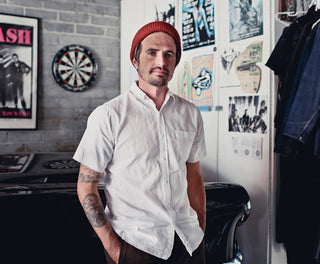Founded in 2004, Brixton is a timeless apparel brand fueled by a collective of counter cultures, but forever inspired by easy Southern California living. Conceived through the vision of co-founder David Stoddard, the independent imprint is nearing a decade of relevance with its consistent range of clothing that highlights just about everyone and excludes none. Designed around the interests of David, his business partners, and talented team of creatives, the brand – whose name was inspired by English punk band The Clash – has grown tenfolds since its humble beginnings as a headwear startup out of Stoddard’s garage.
An idea deeply rooted years before its inception, Brixton became a reality during David’s career at TransWorld Magazine, where he started as a warehouse worker earning $6 an hour and progressively developed through marketing, sales, and advertising over the course of a decade. Self-taught through it all, he’s witnessed success and experienced failures in an ever-evolving and non-apologetic industry.
This past week, I took a drive down the coast to Oceanside to catch up with David and hear his story, which he’s never told candidly before. I heard his struggles, his triumphs, and all the memories of growing up in a transient town sometimes forgotten due to its close proximity to San Diego, but forever prideful. In his own words below, David recalls the moment he realized laying down tiles wasn’t his calling and tells his rollercoaster tale of the past 10 years; broken down into short chapters, each signifying the progression of a little brand that could.
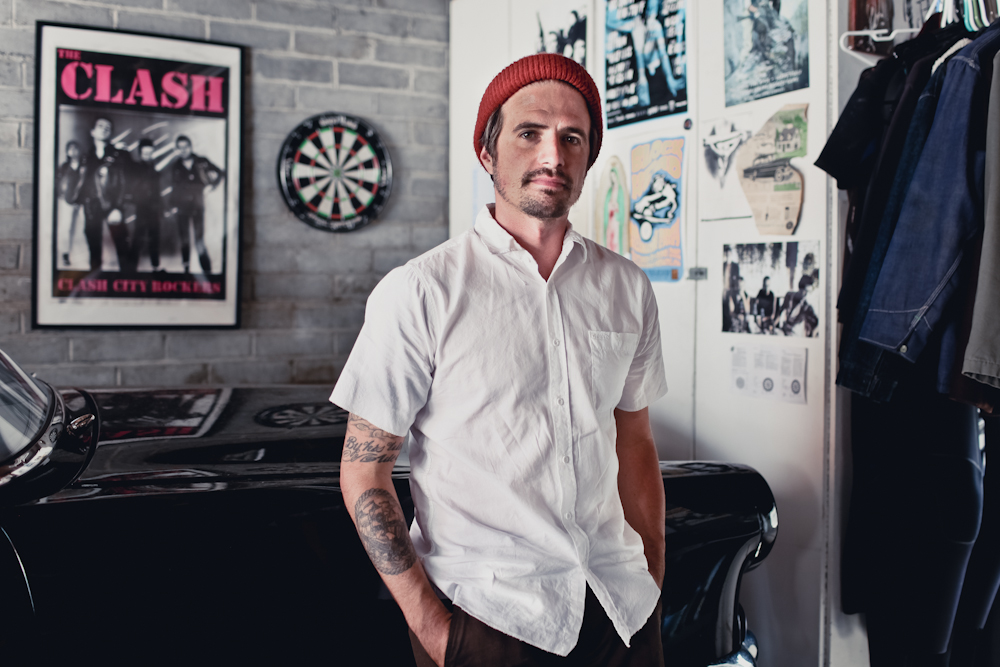
Brixton co-founder David Stoddard in his garage dubbed The Laundry Room
CHAPTER 1 :: STARTED FROM THE BOTTOM
I had a feeling I wasn’t doing what I was supposed to be doing in life, even after I started my own tile company. Growing up, I wanted to start my own brand, I wanted to be an art director, but I ended up being a blue collar labor worker. I was 20 years old, and one day, while loading heavy tile up these stairs, I just said, “Fuck this, I know I could be doing more. I’m supposed to be doing something else. I’m 20 years old and if I don’t change now, I’m going to be doing this for the rest of my life.”
That day I signed up for Palomar College to learn about art direction and then [promptly] called my friend, Charlie, who worked at Transworld Magazine at the time. I asked Charlie, “Can you get me an interview? I’ll take your trash out, I’ll sweep your floors, I’ll do whatever you want me to do. I’ll tile your house for free.” He got me an interview two weeks after I called him.
So I went to this interview and while I was walking to my car, they ran after me and said, “We want you to have the job.” For me, at that moment, I thought I made it. Even for a warehouse job, making $6 an hour, I was so excited because when I was younger I used to silk screen all these shirts [at a local print shop] for Transworld and Invisible Skateboards and now I was working for them.
At Transworld, the warehouse was across the street from the actual offices, so I was across the street, I wasn’t with everyone. There was Dave, Swift, Ako, and Atiba, and those guys had such cool jobs shooting photos and putting the magazine together.
PHONE EXTENSIONS…
I used to look at the [phone] extension list and I would point to it and be like, “One day I’ll have my own extension if I keep working hard [laughs] I’ll move across the street and I’ll have an extension.”
In time, I ended up moving to product sales… So I would make my TransWorld T-shirts and videos and sign shops up for magazines. It was like that for three years until I got offered the Art Director job for TransWorld’s business magazine, TransWorld Business. I instead decided to move into advertising sales where I remained for seven years.
That’s where I really got to meet all these people that started their own companies. These guys were all like heroes to me because they were either professional skateboarders or brand owners, so I really looked up to a lot of them and learned a lot from them. I opted for advertising because I saw all those guys were buying houses and traveling. So I figured, “If I go in this direction, I think I’ll do well for myself.” It was my dream job, I got to work with brands [I admired] and go over all their marketing plans and book their ads. I also got free clothes and free shoes! At that time I wanted to be a famous musician and play music for the rest of my life. Beyond that, I was doing my dream job.
In ’98, I finally got my phone extension. I was so excited I called my parents and was like, “I got my own voicemail!”
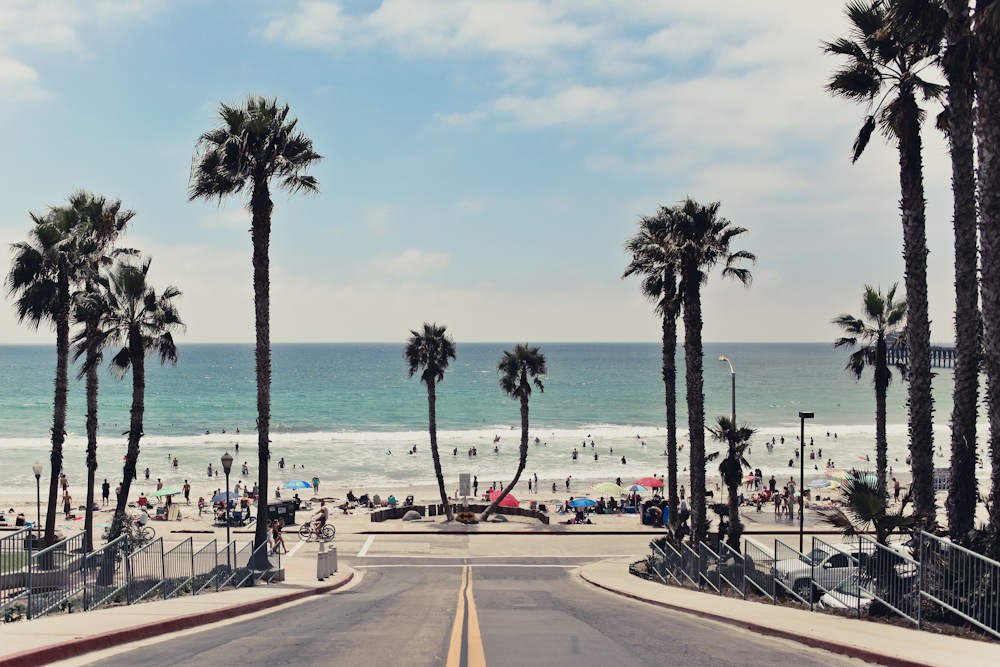
A view of Oceanside, California on a warm summer day
CHAPTER 2 :: DAYDREAMING
I still had that desire to have something I could call my own; my own brand. During my time at TransWorld I was always looking for a name. After a 5-year thought process I decided on Brixton. I wasn’t sure if it was available, so I called my friend Vinny (De La Peña), who owned Ezekiel at the time, and got his trademark lawyer’s information. I called him to see if it was available. He said yes. I had ideas, I didn’t want to start a clothing brand because I had no money. I couldn’t compete and start a T-shirt brand because it would fail, so I wanted to start something different and unique that nobody was offering.
Jason Young, who I worked with [at TransWorld] and played music with, said, “Hey, let’s do this together.” He’d actually seen me spray paint Brixton on the bottom of my skateboard and surfboard. He always said, “You have something there.” He came to me and presented Mike [Chapin], my eventual third business partner, who had an MBA in finance. It was kind of the perfect triangle. I had the brand, vision, idea – Jason would have logistic sales, and Mike would handle finances.
During my time in sales I was able to save up enough to buy a condo, so I took ten grand from equity [to start Brixton]. I just said, “Fuck it, if I lose it, I lose it, but if I don’t try this I’ll hate myself.” Jason also put in $10k and Mike put in $10k. Out of that money we basically had to buy product and use it for marketing.
TAKING THE LEAP…
We went for it. We started out of my garage, we worked at TransWorld during the day and on Brixton at night. We started with headwear because we weren’t competing with anyone. The aesthetic fit really well with what we wanted to do because no one was doing it. We knew that if we saw a pub mirror in a skate shop, it would look so different from anything else there. We launched in 2005. Having worked in marketing, I knew you had to have a consistent message, so we went after ad space. We still had to pay for ads, I didn’t get them for free, even though I sold ads. I booked a 2/3rds space up in the front [of the magazine] and I’d continue booking it every other month. I booked the year and we went for it. We had so many ideas with the photography because we were very much into having things look old and timeless, and premium. So all our ads would reflect that.
Jason was the first to leave TransWorld, then Mike, then myself. I was the last to go because I was actually scared to leave; I had a great job. I worked so hard to get to that point in my life that it was really scary for me to leave. But I kept going back, I kept taking chances with everything. Even with being a tile setter to moving into product sales and into advertising – I knew if I didn’t do it, I would hate myself for the rest of my life for not trying it and saying, “What if I did that?” So I took a humongous pay cut. They basically had to push me out the door at TransWorld. [laughs]. So I went from having an extension to using a walkie talkie [laughs]. I remember looking up going, “We have to get an extension list. Oh my god, I don’t have an extension anymore.”
We had a space the size of two car garages. We sat across from each other and at that point, I sat there and said, “Okay, here we go.” One of the best decisions I ever made.
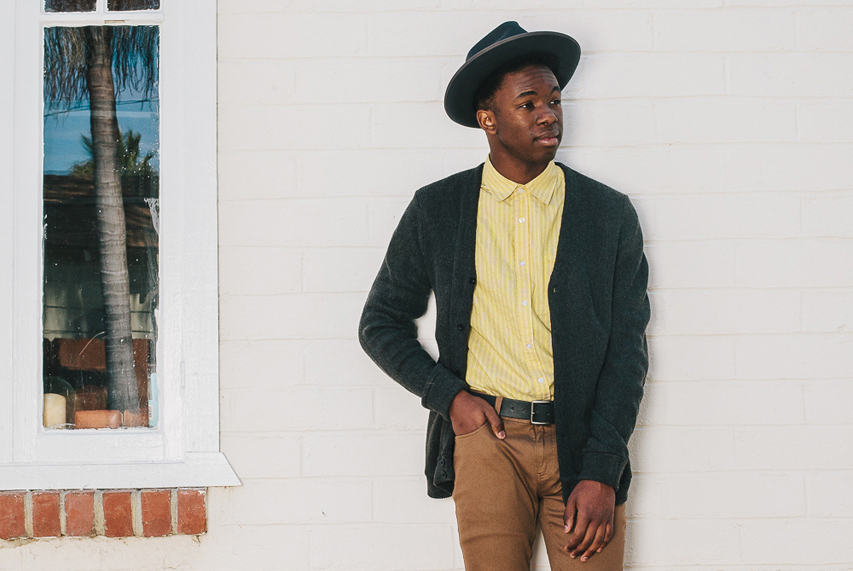
A look inside Brixton’s 2014 Spring lookbook
CHAPTER 3 :: THE BEAUTIFUL STRUGGLE
When we launched, we knew we wanted to do more than just headwear, so we made sure we didn’t put ‘Brixton Hats’ on everything, we didn’t buy Brixtonhats.com, we just made sure it was just Brixton. Our first accounts were Active Rideshop and Surf Ride, whom we developed relationships with during our time at TransWorld. That’s how we got our first order. It was a dream come true, it was very surreal. Surf Ride was the local store in our home town, so it meant that much more.
The hats luckily sold well, to where retailers actually started pre-booking. From there, we kept working and working and we knew we wanted to do more than just headwear. So we thought jackets made sense.When you walk into a pub, you take off your hat and coat and hang it on the mirror rack. That story fit perfectly with Brixton’s vision. It was like a natural progression.
So we did that. We did well with flannels, then moved to jackets, and then some accessories, but we kept doing jackets, button-ups and tops, until we could afford to do bottoms and then we launched bottoms. But we took our time launching pants, because we knew that you only had one chance to make sure that they fit right. So we worked really hard on finding a great manufacturer for us and it’s been three years since.
One of the challenges for us – as a brand that didn’t have any outside investing – was finding manufacturers that wanted to work with a small brand. And that was the hardest because you’d get manufacturers that would have poor quality product but you didn’t have a choice. So you’d have to do the best you could and hope that the look and aesthetic would push the sails through. We’ve had great manufacturers, we’ve had poor manufacturers, we’ve had huge mistakes, but we got through them all.
MISTAKES ARE LIFE LESSONS…
I honestly cannot believe how far we’ve made it with all that, but it really comes down to having a vision and passion and we just did whatever it took. We were so excited about our early cut-and-sew pieces but the fits were horrible. We learned so much the hard way because we did this from my garage and we had no apparel experience in the beginning.
One time, we had $40,000 dollars worth of wovens that was our first delivery to the warehouse and I couldn’t ship them. They were so bad that I would hurt the brand [by putting them out] and I was so excited to have a cut-and-sew garment on the market, but we had to sit there and go, “We can’t do this.” Before we had fit technicians, we had to fit it off ourselves. Which I was two inches off from a fit model in every capacity [laughs]. But we would just fit it on ourselves and go, “Yep, this looks good.” We had no fit technician. We were really excited when we grew large enough to hire a fit technician.
We made mistakes, we tried to make women’s way too early. We hadn’t perfected men’s yet and we needed to be the best at men’s before doing women’s, so we stopped [producing women’s apparel] and focused only on women’s headwear. But it happens to everyone, it’s normal. You really have to focus and know what you’re good at and then do that the best way you can and then grow from there and that’s we did.
We got too excited in the beginning. I wouldn’t take any of that back though, no way. Those are learning lessons, those are school. To me, TransWorld was like a school, Brixton was as well.
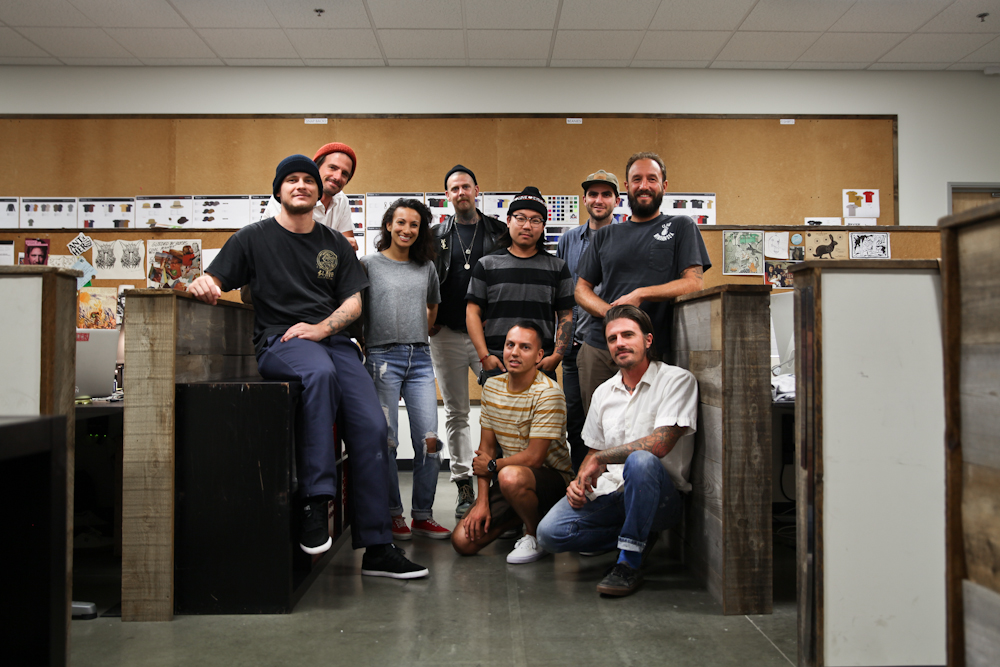
The Brixton Design Team with David & Peter Stoddard
CHAPTER 4 :: FAMILY
Where we grew up and the culture we grew up in was amazing. I always wanted to retain that for everyone that came in and worked here.
My brother had a different path in life, he had kids young and he was working at an auto body shop. But he always had a good eye for things and people always looked at him for what he was wearing all the time, but he had nothing to do with my industry. He couldn’t tell you which skateboarder was which, but he grew up doing it [skateboarding] and he loved doing it. He just didn’t care about the industry stuff.
When I started Brixton, I’d always turn to him and say, “What do you think of this? What do you think of that?” So as we kept growing I was like, “I know I’m going to grow out of this and I need someone that is better at this than I am.” And I know my brother is good, he is the brand, we grew up doing the same thing and we had the same vision.
So I hit him up one day and was like, “Yo, take Illustrator classes and learn this because in about six months to a year I’m pretty sure that you could take this job [from me].” At the time he hated his job, but it was tough because he had two kids and a wife and he couldn’t just leave. We were able to grow the brand enough to where I grabbed him. He did the same thing, he took a pay cut to do it, same thing I went through, but he was more happy doing it. To me, he brings a different side to the brand, as the Design Director, which makes it what it is today. I would say it’s the darker side but, again, it has legitimacy and authenticity to it.
LOCAL CULTIVATION…
Everyone here is from around my hometown. We couldn’t hire executives at the time, so we brought in friends. It’s hard to work with friends, at times, but it’s important to me to hire the people around me and hopefully they can grow too. We’ve had some leave unfortunately, but at the end of the day I want to create a place where people feel stoked to come in every day and work somewhere cool where they get to do something fun and creative.
I hope that they love the culture or something that we’re about because if you don’t get it then there’s going to be a missed message in the company. And we’ve had that experience, we’ve hired people – more on the administration side, but that still affects things – people in the past that didn’t get our lifestyle or culture and it just didn’t work with anybody, so moving forward we interview every single person that comes through the door to make sure they understand the culture.
Growing up, I’d ask myself why there weren’t any brands from Oceanside. There’ successful brands from Orange County and LA, but how come there are none from Oceanside? Only because I thought there were so many talented people here and there’s such a diverse culture. Obviously I’m proud to be from here. So I was very excited to have a brand from Oceanside representing everything we do, everything you see from when you walk in our warehouse. All the people, it’s just a great representation of the brand and the diverse cultures and everything everyone is into.
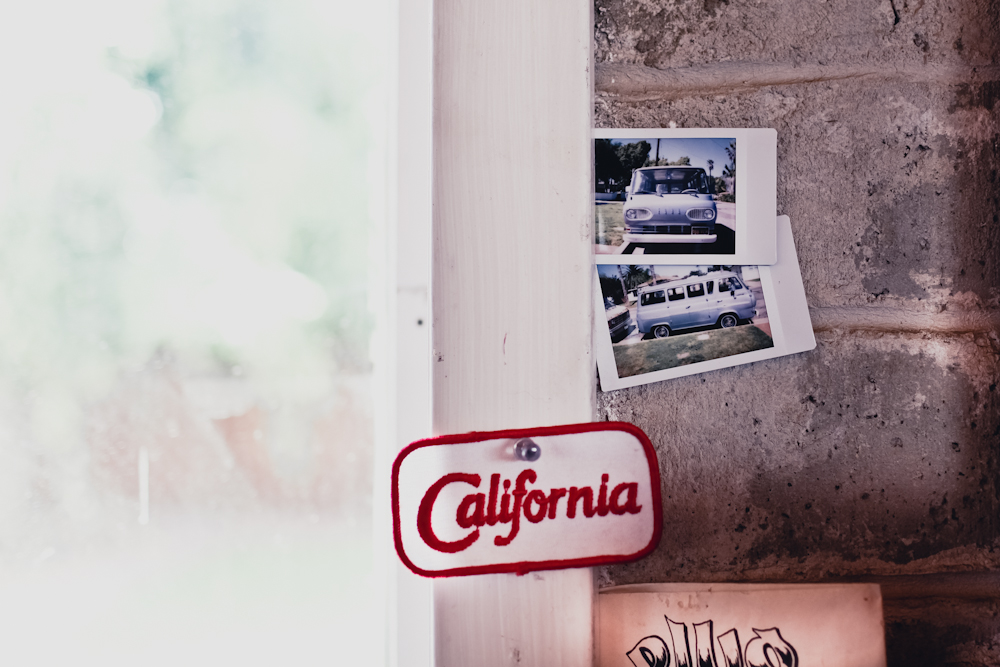
CHAPTER 5 :: ALWAYS MOVING FORWARD
You have to take chances. There’s different levels of sacrifice and when you get to them you have to keep going. When I was at TransWorld I became friends with these guys at brands. We watched guys grow brands from zero to three hundred, four hundred million dollar brands. So even through this process I had high expectations, I knew where you could take it. As you keep growing – everyone says [the hardest thing is] when you get to five [million dollars]… Then the hardest part there is to get from five to ten.
Then you reach those and they’re milestones for you. And you are ecstatic and feel proud, but then you know you’ve just begun and you take the next challenge. But you have to protect your brand and grow while you do it. It’s very easy to destroy a brand through that time, so you have to protect it and your same vision from the very beginning and take council.
But the one thing you have to have is passion and you have drive, and the vision of the end of what it all looks like. One of my mentors told me the best thing, “You should stand across the street and pretend that store is a Brixton store and what you want it to look like and keep it that way.” I think of that every time: What do I want people to think when they walk by?
I tell everyone, you have to wake up and do something for a living. For money, but let’s do it with something that we love to do. And a brand that you can believe in. That’s what I tell all our sales reps. [laughs] I’ve woken up and went to work and hated my job. People complain about their job and I know it’s hard, but you can change it.
You can change.
You can 100% change. It takes sacrifice and you might have nothing but you have to know that it’ll get better. I’m proof, I had nothing.
::
Follow the latest happenings from Brixton through the brand’s official Instagram (HERE) and more via Brixton.com.

